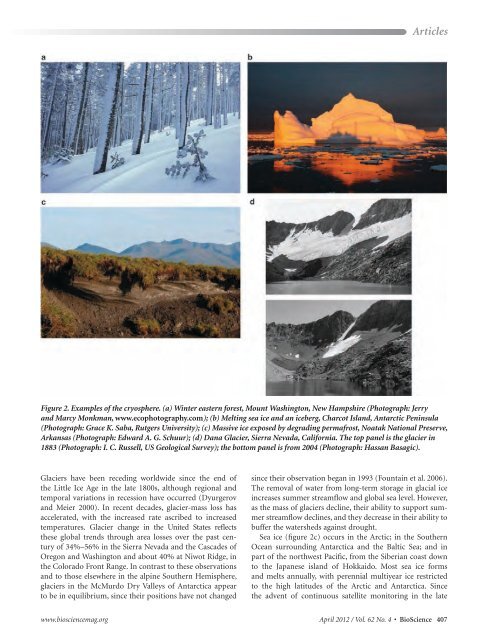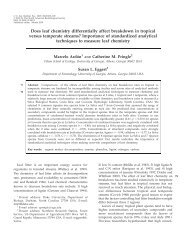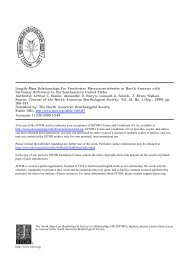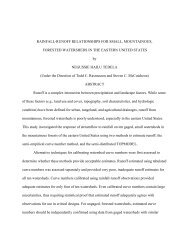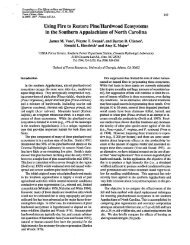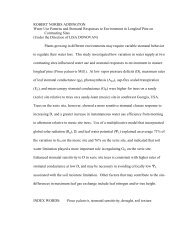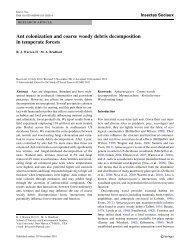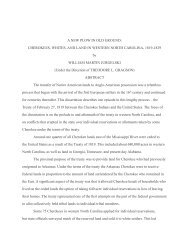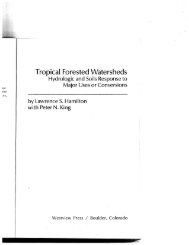biology join - Coweeta LTER - University of Georgia
biology join - Coweeta LTER - University of Georgia
biology join - Coweeta LTER - University of Georgia
You also want an ePaper? Increase the reach of your titles
YUMPU automatically turns print PDFs into web optimized ePapers that Google loves.
Articles<br />
Figure 2. Examples <strong>of</strong> the cryosphere. (a) Winter eastern forest, Mount Washington, New Hampshire (Photograph: Jerry<br />
and Marcy Monkman, www.ecophotography.com); (b) Melting sea ice and an iceberg, Charcot Island, Antarctic Peninsula<br />
(Photograph: Grace K. Saba, Rutgers <strong>University</strong>); (c) Massive ice exposed by degrading permafrost, Noatak National Preserve,<br />
Arkansas (Photograph: Edward A. G. Schuur); (d) Dana Glacier, Sierra Nevada, California. The top panel is the glacier in<br />
1883 (Photograph: I. C. Russell, US Geological Survey); the bottom panel is from 2004 (Photograph: Hassan Basagic).<br />
Glaciers have been receding worldwide since the end <strong>of</strong><br />
the Little Ice Age in the late 1800s, although regional and<br />
temporal variations in recession have occurred (Dyurgerov<br />
and Meier 2000). In recent decades, glacier-mass loss has<br />
accelerated, with the increased rate ascribed to increased<br />
temperatures. Glacier change in the United States reflects<br />
these global trends through area losses over the past century<br />
<strong>of</strong> 34%–56% in the Sierra Nevada and the Cascades <strong>of</strong><br />
Oregon and Washington and about 40% at Niwot Ridge, in<br />
the Colorado Front Range. In contrast to these observations<br />
and to those elsewhere in the alpine Southern Hemisphere,<br />
glaciers in the McMurdo Dry Valleys <strong>of</strong> Antarctica appear<br />
to be in equilibrium, since their positions have not changed<br />
since their observation began in 1993 (Fountain et al. 2006).<br />
The removal <strong>of</strong> water from long-term storage in glacial ice<br />
increases summer streamflow and global sea level. However,<br />
as the mass <strong>of</strong> glaciers decline, their ability to support summer<br />
streamflow declines, and they decrease in their ability to<br />
buffer the watersheds against drought.<br />
Sea ice (figure 2c) occurs in the Arctic; in the Southern<br />
Ocean surrounding Antarctica and the Baltic Sea; and in<br />
part <strong>of</strong> the northwest Pacific, from the Siberian coast down<br />
to the Japanese island <strong>of</strong> Hokkaido. Most sea ice forms<br />
and melts annually, with perennial multiyear ice restricted<br />
to the high latitudes <strong>of</strong> the Arctic and Antarctica. Since<br />
the advent <strong>of</strong> continuous satellite monitoring in the late<br />
www.biosciencemag.org April 2012 / Vol. 62 No. 4 • BioScience 407


